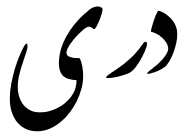Language/Dari/Grammar/Nouns
Hi Dari learners! 😊
In this lesson, we will focus on the basics of Dari grammar as it pertains to nouns.
Consider broadening your understanding by checking out these related lessons: Dari Grammar: Past Tense, Gender, Describing People and Things & Questions.
Introduction[edit | edit source]
Nouns are the foundation of any language, and Dari is no exception. In Dari, nouns can be further classified as animate or inanimate, singular or plural, and masculine or feminine. Understanding these classifications is essential in constructing sentences that make sense.
To improve your Dari Grammar, you can also use the Polyglot Club website. Find native speakers and ask them any questions!
Animate vs. Inanimate Nouns[edit | edit source]
Animate nouns refer to living creatures, while inanimate nouns refer to non-living entities. Here are a few examples:
| Dari | Pronunciation | English |
|---|---|---|
| شیر | /ʃir/ | lion |
| پیل | /peil/ | elephant |
| آسمان | /aːsmaan/ | sky |
| خاک | /xaak/ | soil |
Notice how the first two words refer to living beings, while the latter two refer to non-living entities. This distinction is important because animate and inanimate nouns take different forms depending on their role in the sentence.
For example, in a sentence like "The lion ate the antelope," the word for "lion" would be in the nominative case, while the word for "antelope" would be in the accusative case. We will cover case further in another lesson.
Singular vs. Plural Nouns[edit | edit source]
Another important classification of Dari nouns is singular versus plural. In English, we add an "s" to the end of a noun to make it plural (e.g. "dog" becomes "dogs"), but in Dari, pluralization is a bit more complex.
One way to make a noun plural is to add the suffix "-hā" to the end of the word. For example, the word for "house" is خانه (khāneh) in the singular, and خانه ها (khāneh-hā) in the plural.
Let's see some examples:
| Dari | Pronunciation | English |
|---|---|---|
| کتاب | /ketɒːb/ | book |
| کتاب ها | /ketɒːb-hɒː/ | books |
| مرد | /mærd/ | man |
| مردان | /mærdɒːn/ | men |
In addition to suffixes, there are other ways to create plurals in Dari that we will cover in another lesson.
Masculine vs. Feminine Nouns[edit | edit source]
In Dari, nouns are either masculine or feminine. This distinction affects how adjectives are used to describe the noun, as well as the suffixes used to form the plural.
Here are some examples:
| Dari | Pronunciation | English |
|---|---|---|
| دست |
/dæst/ || hand (feminine) | |
| دست ها |
/dæst-hɒː/ || hands (feminine) | |
| خدا |
/xodɒː/ || God (masculine) | |
| خداوندان |
/xodɒːvændɒːn/ || Gods (masculine) |
As you can see from the above examples, the feminine form of a noun tends to end in "-a," while the masculine form does not have a consistent ending. We will cover gender further in a future lesson.
Dialogue[edit | edit source]
Let's see some of these concepts in action:
- Person 1: این کتاب یکی از محبوب ترین کتاب هاست. (īn ketāb yekī az maḥbūb-tarīn ketābhāst.) (This book is one of the most popular books.)
- Person 2: مراقب باش، این کتاب را روی زمین گذاشتی! (morāqeb bāsh, īn ketāb rā rū-ye zamīn gozāshtī!) (Be careful, you put the book on the ground!)
Conclusion[edit | edit source]
Nouns are a fundamental part of any language, and in Dari, it is important to understand the classifications of animate vs. inanimate, singular vs. plural, and masculine vs. feminine. Practice incorporating these concepts into your spoken and written language, and you will be well on your way to mastering this beautiful language.
Sources[edit | edit source]
With this lesson finished, you may want to explore these additional pages: Resources, Plurals & How to Use Be.
Other Lessons[edit | edit source]
- Questions
- Conditional Mood
- Plurals
- How to Use Be
- How to Use Have
- Give your Opinion
- Adjectives
- Gender
- Negation

